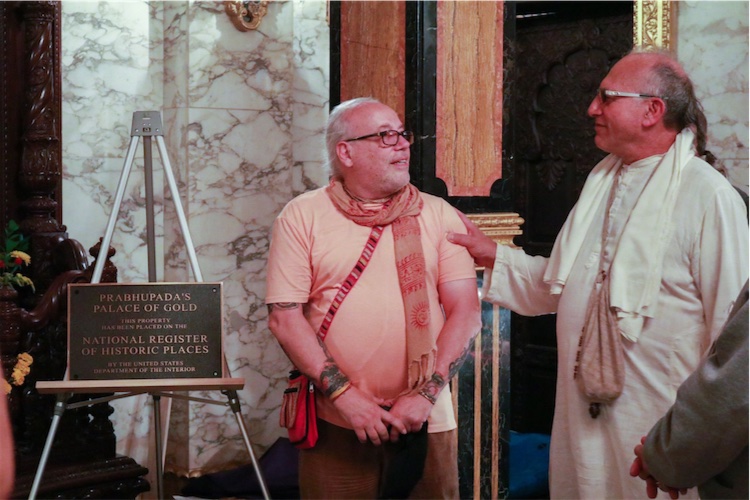Prabhupada’s Palace Added to National Register of Historic Places
By Madhava Smullen | Oct 07, 2019

Srila Prabhupada’s Palace in New Vrindaban was officially listed on the National Register of Historic Places on August 28thby the West Virginia State Historic Preservation Office, the Department of the Interior, and the National Park Service.
Around seventy devotees from around the US gathered on Friday September 27th, during the opening ceremonies for the 40th Anniversary of the Palace, to celebrate the distinction.
They formally dedicated a cast bronze plaque commemorating the achievement, and offered it to Srila Prabhupada’s murti in his Palace.
“For the past number of years, we’ve been trying to get the Palace a status as a historic building in West Virginia,” said Palace Reunion Festival organizer Sukhavaha Dasi, to cheers from the crowd. “It’s a federal thing, not just a state thing, backing that this is a historic building!”

Rshabadeva (left) and Gopisa, two of the devotees who helped get the National Register listing, share a moment
After the brief ceremony, devotees carried Srila Prabhupada’s murti around the Palace, circumambulating it several times in celebration. There was also kirtan and a prasadam dinner.
The event was covered on the front page of local newspaper the Wheeling Intelligencer, which quoted longtime resident and former teacher Lilasuka Dasi as being overjoyed with the recognition the Palace of Gold received.
“It’s about time, because I feel that our spiritual master brought a lot of elevated consciousness, of a lot of things, to the western world,” she said in the article. “Vegetarianism is really increasing here in the West, and I feel it’s because of our spiritual master. And the Palace, it brings so many people to West Virginia, it brings people to Marshall County.”
Getting Srila Prabhupada’s Palace listed on the National Historic Registry took several years of concerted effort by a number of dedicated people.

The National Register of Historic Places Plaque
They are: Jaya Krsna Dasa, former President of ISKCON New Vrindaban; Vrajakishor Dasa, former manager of Prabhupada’s Palace; Rshabadeva Dasa, general assistance; Gopisa Dasa, legal and logistical support; Chaitanya Mangala Dasa, archival resource and logistical support; and Jeff Smith, Structural Historian and National Register and Architectural Survey Coordinator at the WV State Historic Preservation Office.
“Normally a building isn’t eligible till after it has been around for at least fifty years,” Chaitanya Mangala says. “Exceptions are sometimes made for buildings of ‘exceptional importance.’ With info we provided, and the significant impact it has had in the state of West Virginia, Mr. Smith convinced the West Virginia Archives and History Commission and the National Register Review Board that Prabhupada’s Palace should be listed after only forty years.”
Because of this, Chaitanya Mangala explains, Mr Smith deserves devotees’ appreciation for his significant part in getting Prabhupada’s Palace officially listed in time for its 40th anniversary.
The stunningly ornate Palace was of course built by devotees themselves, initially meant as a residence for Srila Prabhupada where he could retire and translate his books. After his passing in 1977, it became a sacred place.
“And now, this designation gives Srila Prabhupada’s pre-eminent Smrti Samadhi, or memorial shrine, a new level of prestige and national significance,” says Chaitanya Mangala. “It’s another positive step in the never-ending quest to manifest Srila Prabhupada’s grand vision of New Vrindaban being a premier place of pilgrimage in North America.”
In the near future, another upcoming ceremony will see the bronze plaque commemorating the listing officially installed on the Palace wall, where guests will see it as they arrive to take the tour.
Click to see the official announcement on the National Register of Historic Places (scroll all the way to the bottom): https://www.nps.gov/subjects/nationalregister/weekly-list-20190830.htm















